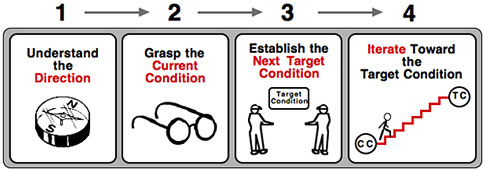AToyota kata is not a list of stuff to do. To help people understand this, I often ask, “What obstacles do you think are preventing you from reaching the target?” I also like to insert the word “now” in there sometimes for emphasis. The intent (as I interpret it) is for the improver or learner to give some thought to the things that must change before the target condition can be reached.
Remember that there are two routines defined in Mike Rother’s Toyota Kata (McGraw-Hill, 2009): the improvement kata and the coaching kata. I’m speculating here, but I suspect there is a legacy from (mis)using “kaizen newspapers,” because in practice they often look similar to obstacle lists. (I believe the original intent of the kaizen newspaper was to function more like the Toyota kata PDCA record, but that’s a topic for another post.)
The improvement kata has four major steps, as seen below:

…
Add new comment